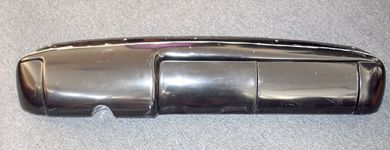
It seems most enthusiasts have strong ideas about what constitutes a street rod, how they should be built, and what they must be equipped with. Of course, for some of us, it's the details that set one car apart from another-the dashboard as an example.
As far as we're concerned, the dash in a street rod has to be practical. The gauges should be in plain view, all the switches should be within easy reach, and a glovebox to stash all your stuff is definitely a plus. Of course we're also talking hot rod here, so the dash has to add some character to the car as well, and one of the best ways to do that is a dash swap. We've always thought dash swaps were cool, particularly when it involved our favorite combination-a '40 Ford dash and a '34 Ford roadster. And that's the very combination we're putting together.
Our roadster is based on a Wescott's fiberglass '34 body. When we ordered it, we asked if a '40-style dash could be installed and, as luck would have it, that turned out to be an unadvertised option. To make the later dash fit, Wescott's has reencountered the upper flange to fit the early body and reshaped the ends slightly, but other than those minor modifications, the shape of the dash is unaltered. And while the 'glass dash lacks any openings for instruments or the stock speaker grille, the glovebox lid is hinged (but not latched).
Our plan was to equip the dash with a DC Street Rods' Deco gauge cluster (see Sept. '05 STREET RODDER) with Auto Meter gauges and a stock-style radio speaker grille and trim from Bob Drake. To finish the dash, the first task facing us was mounting the instrument panel. We were lucky enough to be able to borrow an original steel dash, so cutting the necessary openings for the gauge panel and speaker grille was simply a matter of making patterns and cutting the required holes.
Once the holes were cut, we had to come up with a way to attach everything. The stock Ford dash has four metal tabs on the backside that holds the instruments in place. Our solution was to simply epoxy four studs to the back of the glass dash and make a pair of aluminum retainers to hold the gauges in place. Mounting the Drake trim was just a matter of drilling the necessary holes for the mounting studs. But the real challenge was to find a way to latch the glovebox. We've seen just about every method, including the stock hardware, magnetic catches, springs, even Velcro. But then we thumbed through the Watson's StreetWorks catalog and found the solution-a power cowl vent motor.
At first the idea of a power glovebox door seemed sort of silly, but the more we thought about it, the better we liked the idea. The installation would be easy; it would provide security because, with the ignition off, the lid would be locked. But best of all it would be different (however, that turned out to be not entirely true; the best part was watching it work).
After a quick coat of primer, the dash was assembled and bolted in place and we couldn't be happier with the results. The easy-to-read gauges make it practical, it has the hot rod look we were after, and of course the electric lid provides the gizmo factor we dearly love.